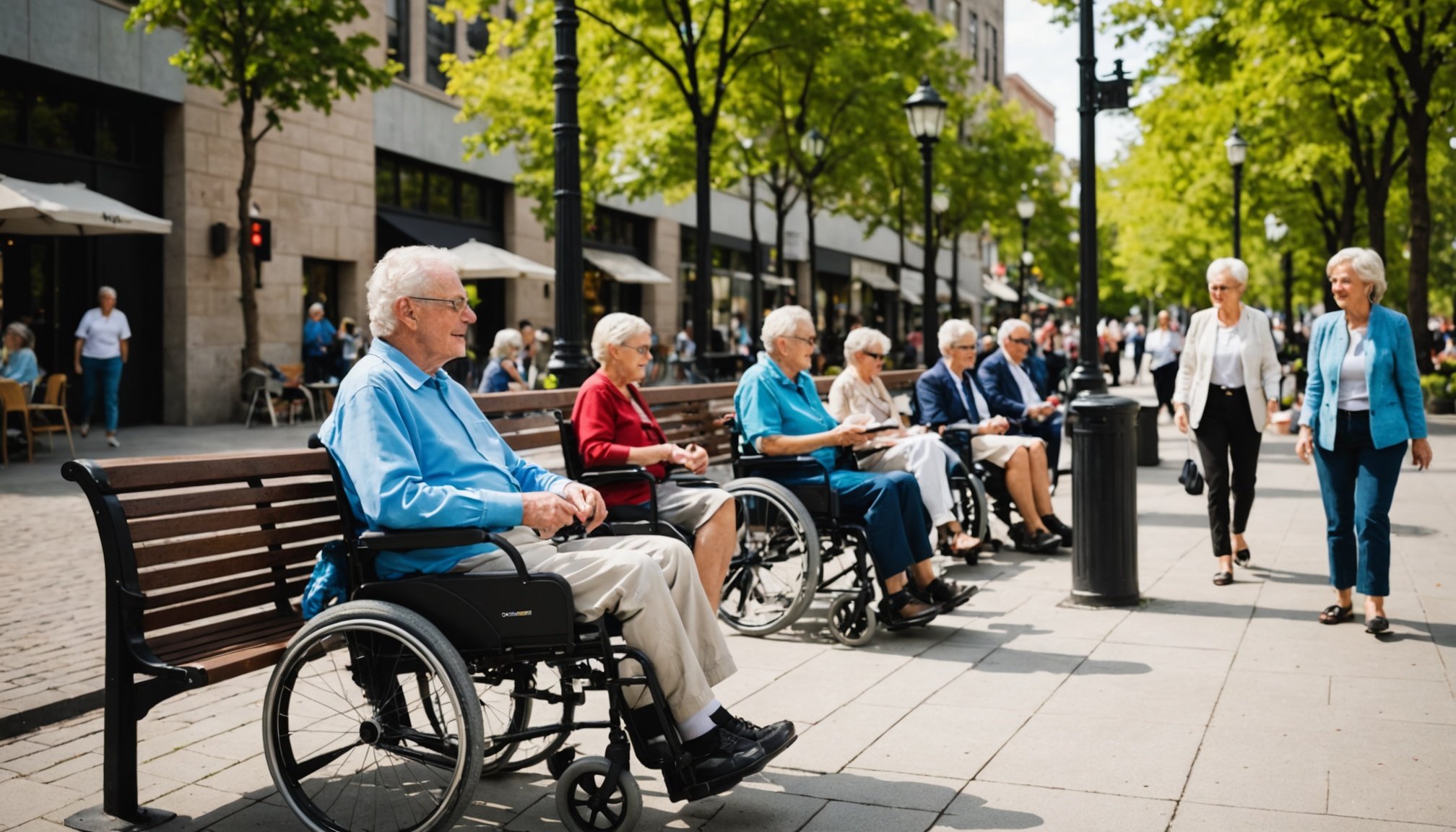Overview of Accessibility and Inclusivity in Urban Design
Creating urban spaces that prioritise both accessibility and inclusivity is vital for catering to diverse populations, especially seniors. Design principles that focus on accessibility for seniors lead to environments where everyone can thrive.
Importance of Creating Spaces for Seniors
Seniors face unique challenges, such as reduced mobility and chronic health conditions, making it crucial for urban design to accommodate their needs. Accessible spaces with ramps and accessible seating enhance their quality of life and independence.
This might interest you : Unlocking the impact of digital connectivity on property values in the uk”s remote regions
Key Principles of Accessible Design
Successful urban design for seniors incorporates:
- Barrier-free environments: Ensure ease of movement for those with mobility aids.
- Strategic wayfinding: Clear and effective signage assists in navigation.
- Adaptable public amenities: Features that can adjust to various needs and preferences.
Benefits of Inclusivity in Public Spaces
When urban designs embrace inclusivity, they do more than cater to seniors—they foster community spirit and social interaction. By integrating diverse needs into the planning stages, cities can transform into welcoming spaces for all ages and abilities.
Topic to read : Mastering the uk property market: expert strategies for thriving amidst economic fluctuations
Public spaces that emphasize inclusivity not only improve social cohesion but also contribute to the mental and physical well-being of their users.
Accessibility Features Essential for Seniors
Creating urban public spaces accessible for seniors is paramount. Ramps and gentle slopes are critical features that facilitate movement for individuals using mobility aids. Unlike stairs, ramps offer a safer, more gradual ascent and descent, which significantly benefits seniors with reduced balance. Importantly, the inclusion of handrails alongside ramps can further enhance safety.
Designing comfortable and ample seating areas across urban spaces is another essential accessibility feature. Seniors often require rest breaks during outings, and strategically placing seating areas can cater to these needs. These seats should have armrests and be of a more prominent, supportive design to assist seniors in sitting and standing comfortably. Additionally, they should be sheltered to offer protection from weather elements.
Clear and effective signage plays a pivotal role in senior-friendly environments. Navigation can become challenging due to memory issues or vision decline. Therefore, signs should be large, clearly readable, and use universally understood symbols. Incorporating tactility or auditory cues can further accommodate different abilities. Enhanced wayfinding promotes independence and builds confidence among senior users, ensuring they can navigate urban areas without unnecessary stress.
Design Principles for Senior-Friendly Spaces
Designing senior-friendly urban public spaces involves the adoption of several key design principles that promote accessibility and inclusivity. Central to these is the concept of Universal Design, which advocates for creating environments accessible to individuals of all age groups and abilities. This approach ensures that urban spaces are navigable and usable by seniors, enhancing their quality of life.
Universal Design
The principle of Universal Design focuses on creating spaces where all users can engage without needing adaptation. This is particularly beneficial in urban areas where seniors might struggle with mobility. Features like non-slip surfaces, adjustable amenities, and seamless connectivity between different areas promote ease of use for everyone, regardless of physical capability.
Human-Centered Design
Implementing Human-Centered Design emphasizes the importance of understanding user needs directly from the seniors themselves. Engaging seniors in the design process enables designers to tailor spaces accurately for their comfort and convenience. Feedback mechanisms allow for continuous improvement and adaptation, ensuring urban areas remain senior-friendly over time.
Flexibility in Usage
Flexibility in design considers varying mobility levels, allowing spaces to adapt to different community needs. This may involve designing areas that can serve multiple functions, such as recreational activities or quiet seating. By embedding adaptability, urban design remains relevant and inclusive for its users.
Case Studies of Successful Inclusive Public Spaces
Example: XYZ Park
XYZ Park offers a stellar example of accessible urban design tailored for seniors. The park’s wide, barrier-free pathways facilitate movement, accommodating various mobility aids. Strategically placed rest areas with supportive seating enhance seniors’ comfort, providing regular intervals for relaxation. Additionally, clear signage and wayfinding aids ensure navigation ease, contributing to a welcoming atmosphere for all users.
Example: ABC Community Center
The ABC Community Center prioritizes inclusivity through diligent community engagement. By incorporating feedback directly from seniors, the center effectively addresses their specific needs. Adaptable spaces cater to diverse activities, from quiet relaxation areas to vibrant community events. This flexibility highlights the center’s commitment to serving its users’ varied preferences and mobility levels.
Example: 123 Plaza
123 Plaza’s success lies in its multifunctional design, accommodating different community needs. The plaza hosts areas for social gatherings, exercise, and solitary reflection. Engaging seniors in the design process ensured these elements met their preferences, leading to a space that resonates with users of all ages. Emphasizing adaptability, 123 Plaza reflects the benefits of inclusive urban planning.
Practical Implementation Strategies
Urban planners prioritizing implementation and effective planning can enhance accessibility and inclusivity for seniors. Community involvement plays a pivotal role in understanding and incorporating diverse needs.
Developing a checklist for design considerations is an initial step. This includes assessing areas for ramps, seating, and clear signage, ensuring they meet senior-friendly standards. Planners should collaborate with local organizations and stakeholders, gaining insights into specific community requirements. Engaging with seniors directly informs planners about their preferences and mobility challenges.
Pilot projects serve as a critical strategy before full-scale implementations. These small-scale versions of proposed designs allow for real-world testing. Feedback collected from these tests can guide refinements and improve effectiveness. For instance, experimenting with different seat designs in public areas can determine the most comfortable and accessible options for seniors.
Moreover, active collaboration with community members fosters a sense of ownership and ensures inclusivity in final designs. Public workshops and meetings provide platforms for voicing concerns and suggestions, making the community feel valued and engaged.
In essence, thoughtful strategy and genuine involvement create urban spaces that truly reflect and cater to the needs of all age groups. This approach facilitates not just accessibility but genuine inclusivity.
Resources and Tools for Urban Designers
Creating accessible and inclusive urban spaces requires the use of well-informed resources and tools. For urban designers, knowledge of local and national accessibility guidelines ensures compliance and promotes best practices. Government resources often provide frameworks to help design spaces with diverse user needs, ensuring comprehensive and inclusive urban design solutions. NGOs may offer additional insights, focusing on specific community needs through their expertise and advocacy.
Government and NGO Resources
Government agencies frequently publish resources such as design standards and accessibility codes. These are crucial for ensuring legal compliance and enhancing the accessibility of public spaces. NGOs like Age UK work towards supporting seniors by sharing valuable research and real-world applications about what truly benefits older populations.
Design Software Tools
Harnessing design software tools can aid in precision and innovation. Programs like AutoCAD or SketchUp enable designers to visualize and plan urban spaces efficiently, keeping accessibility considerations at the forefront. These tools facilitate adjustments that can make a significant difference for seniors and all users.
Educational Materials and Workshops
Continual learning through workshops and courses enriches designers’ skills and broadens their perspectives. Training in accessibility encourages adaptability and introduces fresh ideas for crafting more inclusive urban environments. Workshops also offer networking opportunities to learn collectively from others’ experiences and innovations.
Conclusion and Next Steps
Community involvement is vital immediately after implementing urban design projects, driving ongoing optimisation and adaptation. Collecting feedback from seniors and other users ensures that the design remains effective and continues to address evolving needs. Engaging residents in post-project evaluations encourages a sense of ownership and can highlight new areas for improvement.
Continuous evaluation and redesign are not just beneficial—they are essential. Urban spaces are dynamic and must evolve to meet the changing capacities and preferences of seniors over time. Regular assessments can identify potential barriers and enhance overall accessibility, ensuring these spaces remain relevant.
Building strong partnerships with local organisations, governments, and stakeholders underpins long-term success. These collaborations can secure funding, offer expert insights, and facilitate training programmes that bolster inclusive design efforts. Establishing a network of support keeps accessibility conversations alive and prioritises them within broader urban planning agendas.
By embedding these strategies, urban planners can sustain and enhance accessibility in public spaces. Such efforts create environments where seniors and all individuals feel welcomed, respected, and empowered to engage with their communities, fostering a truly inclusive atmosphere for the future.











